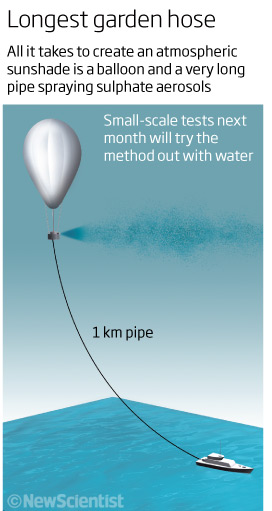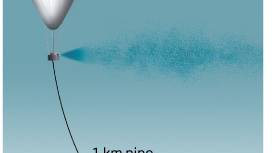Geoengineering trials get under way
Source: newscientist.com
Field trials for experiments to engineer the climate have begun. Next month a team of UK researchers will hoist one end of a 1-kilometre-long hose aloft using a balloon, then attempt to pump water up it and spray it into the atmosphere.
The water will not affect the climate. Rather, the experiment is a proof of principle to show that we can pump large quantities of material to great heights. If it succeeds, a larger-scale version could one day pump sulphate aerosols into the stratosphere, creating a sunshade that will offset the greenhouse effect.

Volcanic ash inspires sunshade (Image: Arctic Images/Corbis)
The trial, led by Matthew Watson of the University of Bristol, UK, is part of a £2 million project called Stratospheric Particle Injection for Climate Engineering (SPICE). Funded by two UK research councils, it also aims to find out the ideal particles to use in an atmospheric sunshade and will attempt to model their effects in greater detail than ever before. The test is not alone: a string of other technologies that could be used to "geoengineer" our environment are being field-tested (see "Coping with emissions").
In his blog, The Reluctant Geoengineer, Watson argues that we need to investigate the effects of sulphate aerosols as a last-resort remedy should the climate start to change rapidly. Researchers contacted by New Scientist agreed with Watson that such research should continue, if only to find out whether the techniques are feasible. "I’d say there’s a 50-50 chance we’ll end up doing it, because it’ll get too warm and people will demand the planet be cooled off," says Wallace Broecker of Columbia University in New York. But there was less enthusiasm for SPICE’s approach to the problem.
There are "large gaps" in our understanding of geoengineering, says Thomas Stocker of the University of Bern in Switzerland. Stocker helped to organise an expert meeting on geoengineering in June for the Intergovernmental Panel on Climate Change. It identified key unanswered questions that should be a focus for research. However, it is not clear that field trials like Watson’s will provide the answers.
One area of doubt over injecting aerosols into the stratosphere is whether it will change the behaviour of high-altitude clouds. That could in turn affect the climate in ways beyond what was intended - and for now, we don’t know how, or how much. Aerosols could also deplete the ozone layer, contribute to air pollution and may alter visibility in the same way as large volcanic eruptions can.
The SPICE test won’t answer any of these questions, says David Keith of Harvard University. "I think it’s a little reckless." The most interesting result will be how the public reacts, he says.
What’s more, Keith adds, in the long run delivering sulphates to the stratosphere with a hose would be a bad idea. Spraying aerosols locally allows the particles to clump together, making them less effective at reflecting sunlight and more likely to be swept down by rain (Environmental Research Letters, DOI: 10.1088/1748-9326/4/4/045108).
Keith’s own studies suggest that if we were ever forced to try to screen out some of the sun’s rays globally, it would be more effective to spray sulphuric acid from aircraft (Geophysical Research Letters, DOI: 10.1029/2010GL043975).
It would also be cheaper, costing a few billion dollars a year according to a study by Aurora Flight Sciences, an aeronautical firm in Cambridge, Massachusetts. Such figures are tiny compared to the trillions that the consequences of climate change could cost the global economy if emissions continue to rise at current rates.
The point, says Ken Caldeira of the Carnegie Institution for Science in Stanford, California, is that experiments like Watson’s, which test relatively simple delivery systems, address the issue of cost. But, since the Aurora study has shown that cost is not a critical factor - a sunshade will be relatively inexpensive - the critical questions relate to potential risks.
More importantly, since a stratospheric sunshade is intended to have a global impact, all countries must agree to such a project and to its precise extent, which is unlikely to happen.
[...]
Read the full article at: newscientist.com






















